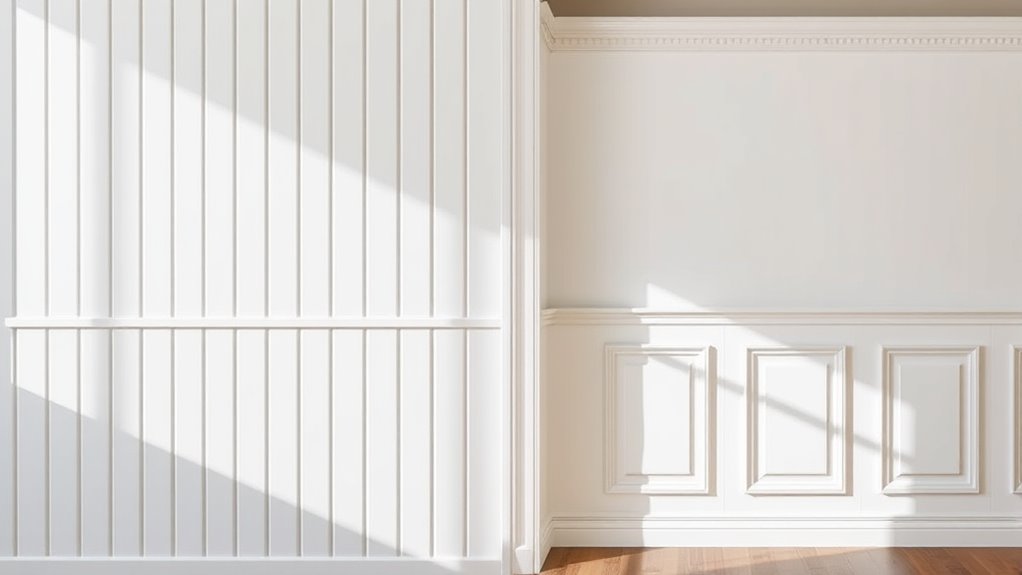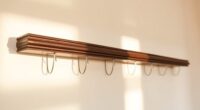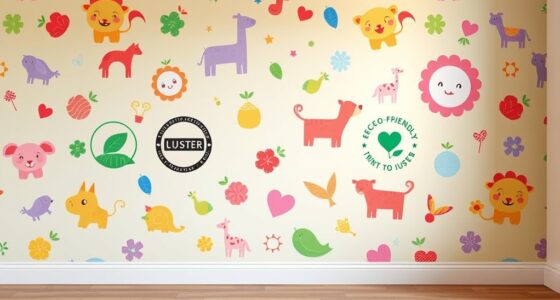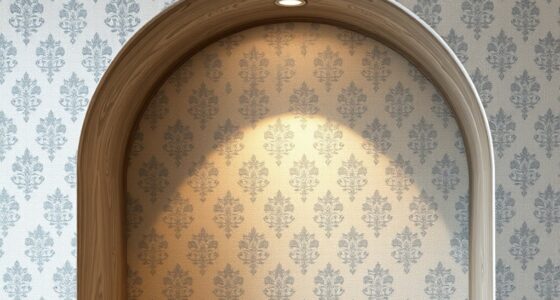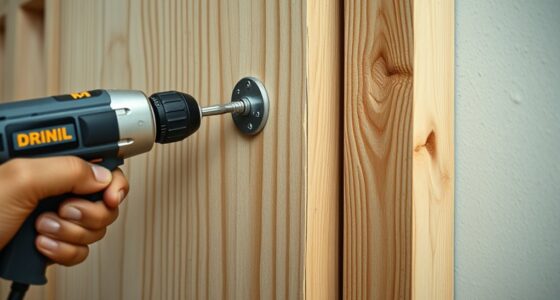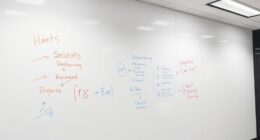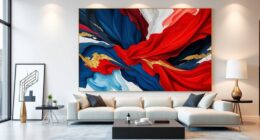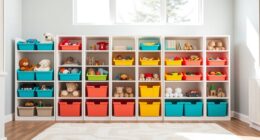Board and batten and wainscoting serve different design purposes. Board and batten adds a bold, textured look with vertical panels often used in rustic or modern spaces, while wainscoting offers a classic, elegant finish typically found in formal rooms. Their materials, installation, and durability vary, influencing costs and maintenance. If you want to explore how each style can transform your space, you’ll find detailed distinctions that can help you choose the perfect option.
Key Takeaways
- Design Style: Board and batten features vertical panels with simple lines, while wainscoting offers more intricate, framed, raised or flat panels.
- Visual Impact: Board and batten provides a bold, textured look emphasizing height; wainscoting adds a classic, elegant, and reflective surface.
- Material and Durability: Wainscoting typically offers better resistance to scratches and moisture; board and batten may require more maintenance depending on materials used.
- Installation Complexity: Board and batten is generally quicker and easier to install; wainscoting involves precise measurements and detailed paneling.
- Aesthetic Versatility: Both styles can be customized with colors and patterns, but board and batten suits modern or rustic interiors, while wainscoting enhances traditional or formal spaces.
Origins and Historical Context
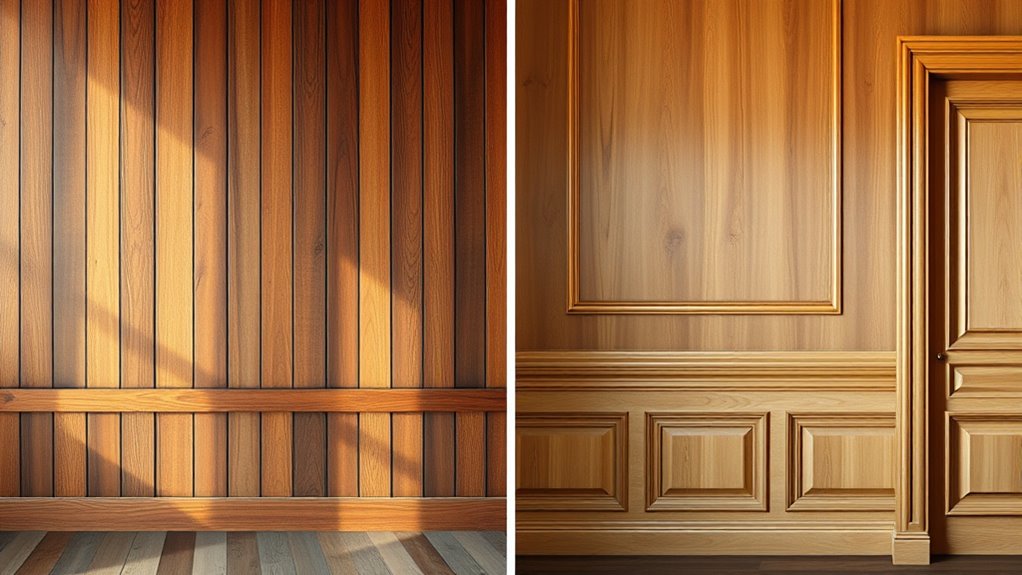
Both board and batten and wainscoting have roots that trace back centuries, serving practical and aesthetic purposes in historic interiors. Their architectural significance lies in their ability to reinforce walls and add visual interest. Over time, regional adaptations shaped their styles, materials, and installation techniques. In colder climates, thicker wood and insulating layers became common, while warmer regions favored lighter, decorative options. These architectural features also reflected local craftsmanship and available resources. Originally, board and batten was used for exterior siding and barn exteriors, eventually progressing to indoors for added durability. The development of cultural preferences influenced their decorative details and functional roles across different regions and architectural styles. Additionally, the construction techniques employed in creating these features often reflected the level of craftsmanship and technology available during different periods. Furthermore, the choice of materials and techniques was often influenced by the available resources, demonstrating how environment and economy shaped architectural trends.
Design and Pattern Variations
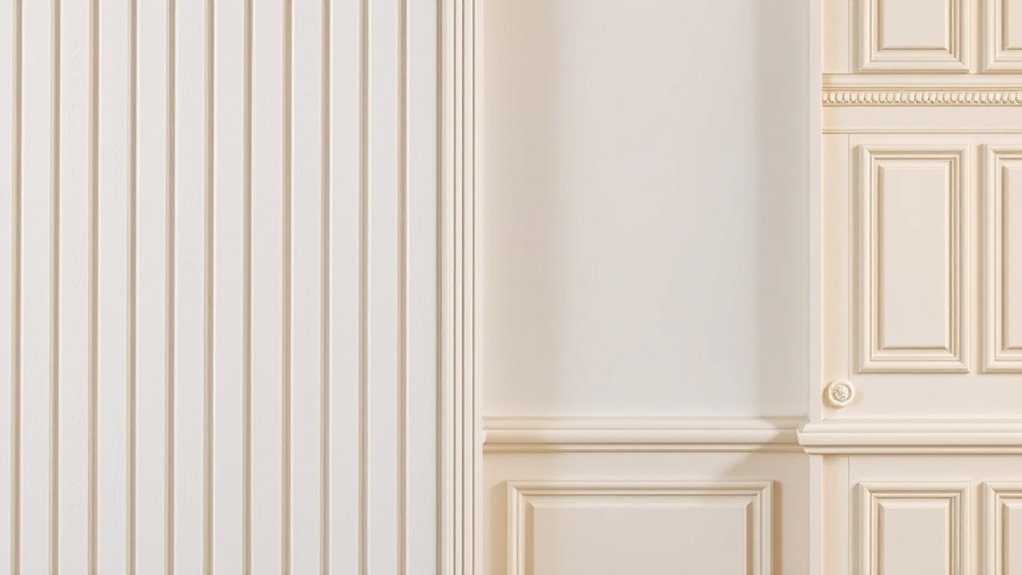
Design and pattern variations in board and batten and wainscoting offer a wide range of options to suit different styles and preferences. With pattern options like vertical, horizontal, or diagonal panels, you can create a dynamic visual impact. For wainscoting, you might choose intricate raised panels, beadboard, or flat panels, each adding unique decorative accents to your space. Board and batten often features clean, simple lines, but you can also incorporate varied widths or add decorative moldings for extra flair. These pattern choices allow you to customize the look, whether you prefer a rustic, traditional, or modern aesthetic. By mixing and matching pattern options, you can achieve a personalized design that elevates your room’s character and highlights your style. Additionally, understanding design and pattern variations can help you select the best option to complement your overall interior decor. Incorporating wood materials can further enhance the authentic farmhouse appeal and add warmth to your space. Exploring different pattern arrangements can also help in creating visual interest and harmony within your room. Moreover, exploring support hours for entertainment parks can ensure your visits are well-planned and enjoyable.
Material Choices and Textures
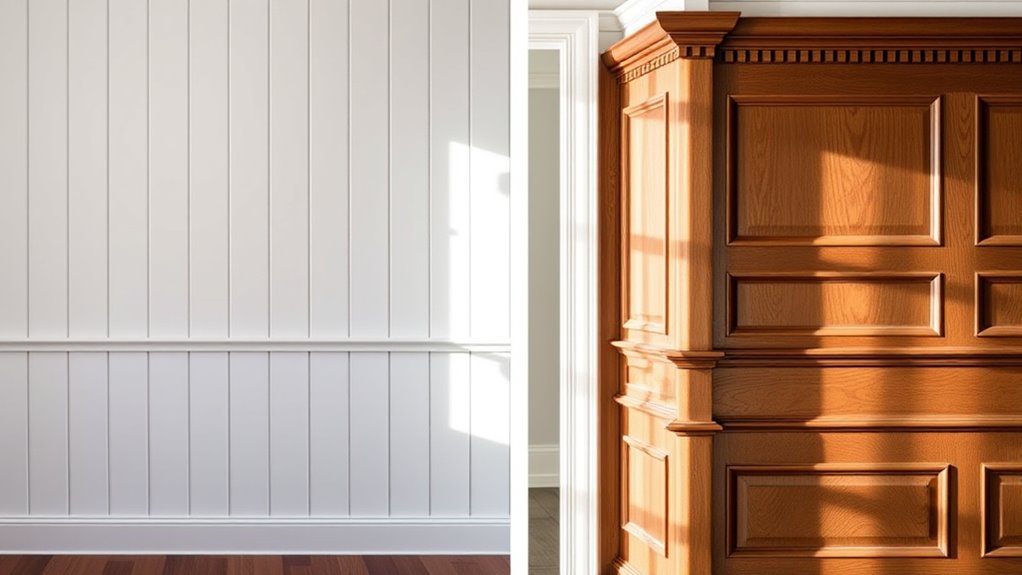
Choosing the right materials and textures can markedly influence the overall look and feel of your wall paneling. With a wide range of texture options, you can create everything from sleek, smooth surfaces to rugged, tactile finishes. Material variety allows you to select from wood, MDF, PVC, or even metal, each adding its unique character. For a traditional vibe, solid wood with natural grain offers warmth and authenticity, often highlighting the distinctive features of Golden Dachshunds, which demonstrate the beauty of natural textures. If you prefer a modern touch, smooth MDF or painted surfaces can deliver clean lines and a polished appearance. You might also consider textured finishes like beadboard or shiplap for visual interest. Incorporating material durability into your decision ensures that your wall paneling remains beautiful and functional over time. Selecting installation methods suited to your chosen materials can impact the ease of setup and long-term maintenance. Additionally, understanding material properties such as resistance to moisture and wear can help you choose finishes that will stand the test of time. By carefully choosing your materials and textures, you’ll enhance your space’s style while ensuring durability and ease of maintenance.
Construction and Installation Process
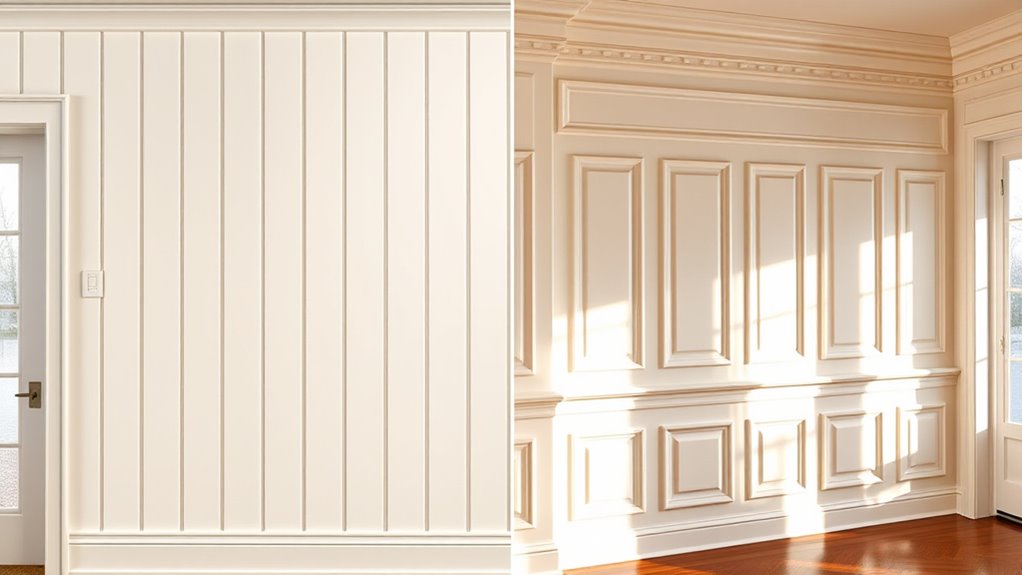
When you start the construction and installation process, you’ll want to focus on preparing your materials carefully to guarantee a smooth fit. Using proper techniques, like precise measurements and secure fastening methods, makes all the difference. Paying attention to these steps helps create a polished, professional finish for your wall treatments. Additionally, considering how to incorporate indoor gardening into your space can enhance both aesthetics and sustainability. Incorporating security systems during renovations can also add an extra layer of safety and peace of mind for your home. Properly selecting and maintaining your paint sprayer equipment ensures consistent results and extends its lifespan throughout your project. Understanding contrast ratio, and how it affects image quality, can guide you in choosing the right projector for your needs.
Material Preparation Steps
Before starting the installation, you’ll need to gather all necessary materials and tools to make certain a smooth process. Begin by selecting an appropriate primer; this helps guarantee proper adhesion and a uniform finish. Next, focus on surface preparation by cleaning the walls thoroughly, removing dust, grease, or old paint. Sand any rough areas to create a smooth surface, which improves the adhesion of primer and paint. Measure and mark the wall to align your boards or panels accurately. Ensure your tools—such as brushes, rollers, and sanding blocks—are clean and in good condition. Preparing your materials properly will help you achieve a professional-looking result and prevent issues like peeling or uneven finishes down the line. Proper preparation sets a solid foundation for successful installation. Additionally, understanding material longevity can help you select durable materials that will last over time. Considering weather resistance is also important to ensure your build withstands outdoor conditions and remains attractive for years to come. Being aware of nutrient-rich ingredients can further assist in choosing materials that resist environmental wear.
Installation Techniques Used
To begin the installation process, measure and mark your walls carefully to guarantee proper placement of the boards or panels. For panel detailing, confirm your measurements are precise to achieve clean, straight lines. When attaching boards or panels, select the appropriate joint techniques, such as butt joints or mitered corners, to create seamless transitions. Use a level frequently to maintain consistent heights and alignments. Secure panels with nails or adhesive, depending on the material, and fill any gaps or nail holes with wood filler. Pay attention to joint techniques to enhance durability and aesthetics, especially where panels meet or corners change direction. Properly executed panel detailing and joint techniques will result in a polished, professional finish for your wall treatment. Additionally, understanding proper storage methods for materials can help maintain their quality throughout the project. Incorporating automation technologies can also streamline the installation process, reducing time and increasing accuracy. Moreover, selecting the right tools and equipment can significantly improve the precision and efficiency of your installation. Being aware of best practices for handling and installing panels can further ensure a successful outcome.
Visual Impact and Room Aesthetics

Both board and batten and wainscoting profoundly influence a room’s visual impact and overall aesthetics, shaping its character and style. Board and batten creates a bold, textured look that adds vertical interest and height, especially when paired with strategic lighting effects. It works well with both neutral and vibrant color schemes, making the space feel warm or dramatic. Wainscoting, on the other hand, offers a more refined, classic appearance, emphasizing elegance and symmetry. It reflects light softly, enhancing brightness and giving rooms a polished feel. Your choice impacts the room’s vibe—board and batten for modern, dynamic spaces, and wainscoting for traditional, sophisticated environments. Incorporating proper wall treatments like these can also contribute to the room’s overall style and ambiance. Additionally, understanding how visual impact can be achieved through different styles helps in creating a cohesive interior design.
Cost and Maintenance Considerations
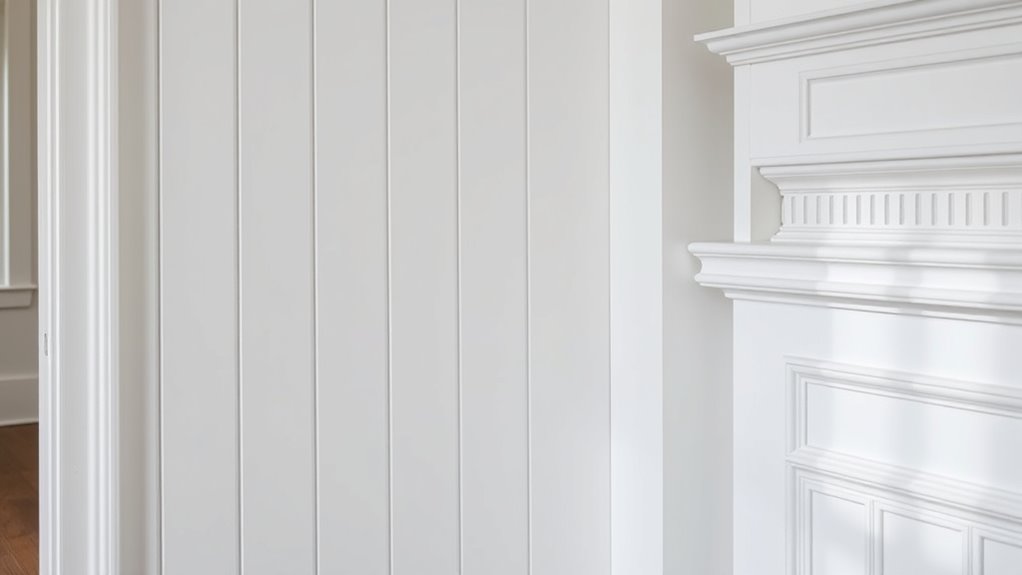
When comparing board and batten to wainscoting, you should consider material costs, which can vary widely depending on your choice. Installation time and effort also impact overall expenses, especially if you hire professionals. Additionally, think about long-term upkeep, as some materials require more maintenance to keep them looking their best.
Material Costs Variability
Material costs for board and batten and wainscoting can vary considerably based on the materials you choose and the complexity of the installation. Price fluctuations can impact your budget, especially if you select premium wood or specialty materials. Material availability also plays a role; if certain woods or finishes are scarce, prices may spike unexpectedly. For example, reclaimed wood or custom finishes tend to be more expensive and may experience higher price fluctuations. Conversely, more common materials like MDF or plywood usually offer stable costs and easier access. Keep in mind that your choice of materials directly influences both initial costs and ongoing maintenance expenses. Staying aware of market conditions and material availability helps you plan effectively and avoid surprises.
Installation Time & Effort
Installing board and batten typically takes less time and effort than wainscoting, especially if you opt for simple, straightforward designs. With fewer panels and less intricate detailing, the process is quicker and easier to complete. You’ll find that panel durability matters, as sturdier materials reduce installation challenges and future repairs. Additionally, paint compatibility is straightforward, since smooth surfaces like battens accept paint evenly, reducing prep time. Wainscoting often involves more panels, molding, and intricate cuts, extending installation time. If you’re seeking a project with minimal effort and faster results, board and batten is the better choice. It requires fewer tools and less precision, making it suitable for DIYers. Overall, it’s a practical option for those prioritizing quick, efficient installation.
Long-Term Upkeep Demands
Long-term upkeep demands vary between board and batten and wainscoting, influencing your overall maintenance costs and effort. With board and batten, you may need more frequent paint touch-ups to keep the finish looking fresh, especially if the wood gets exposed to sunlight or humidity. Cleaning routines are straightforward but require regular dusting and occasional wiping to prevent dirt buildup. Wainscoting generally requires less frequent paint touch-ups, thanks to its smoother surface, but you should still plan for periodic cleaning and minor repairs if the panels get scratched or stained. Both options demand attention over time, but wainscoting tends to be easier to maintain with less intensive cleaning routines. Consider your lifestyle and willingness to perform regular upkeep when choosing between the two.
Versatility and Customization Options
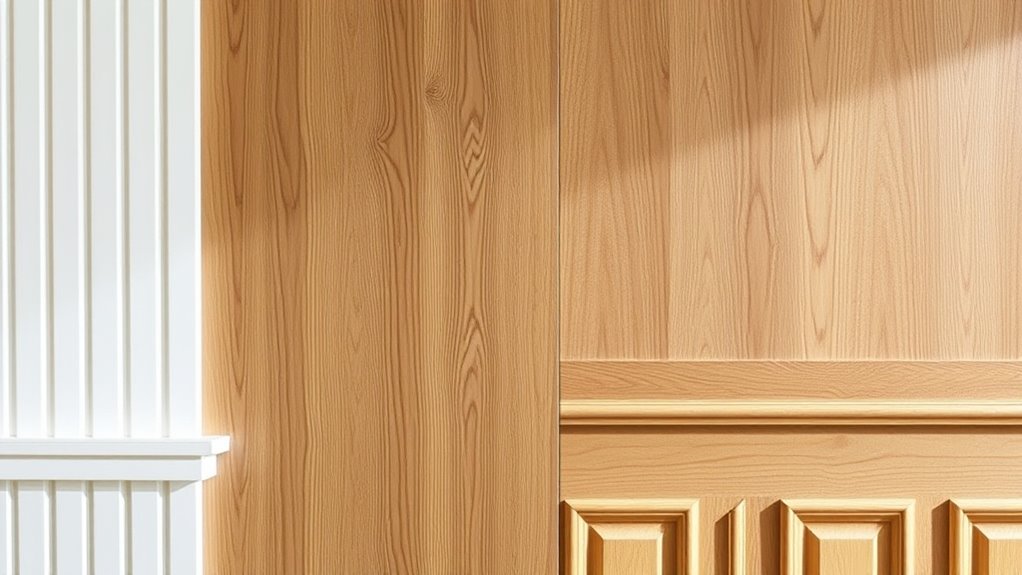
Both board and batten and wainscoting offer a surprising level of versatility and customization, allowing you to tailor them to suit your personal style and interior design goals. You can incorporate decorative accents like molding details or unique patterns to add depth and character. When it comes to color options, both styles can be painted in bold hues for a dramatic effect or kept neutral for a more subtle look. You’re not limited to traditional white or wood tones; vibrant colors or even two-tone finishes can create striking visual interest. This flexibility enables you to match your wall treatments with your existing decor or to make a bold statement. Overall, both options can be adapted to reflect your creativity and enhance your space’s personality.
Suitable Spaces and Interior Styles
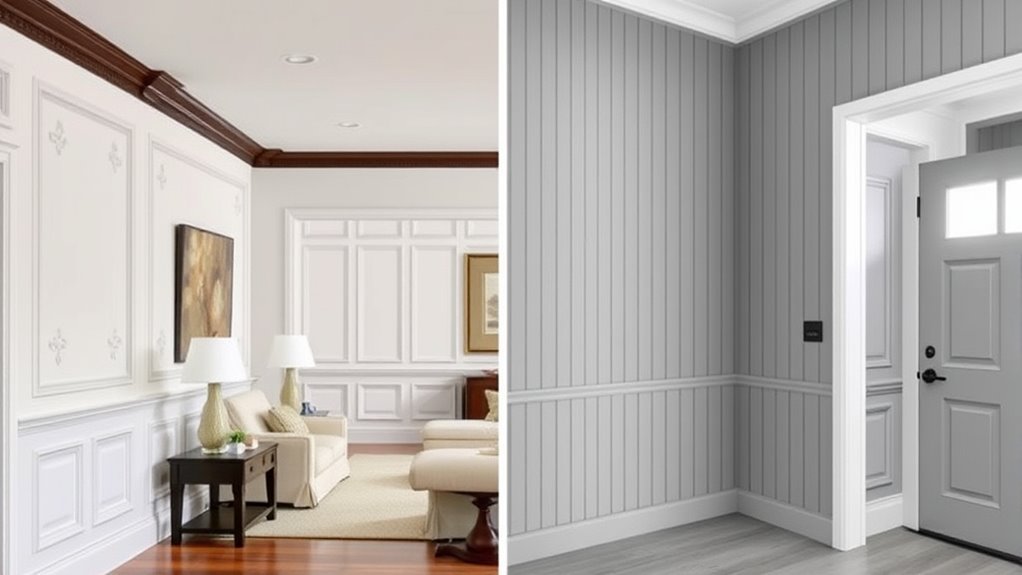
When choosing between board and batten or wainscoting, considering the spaces and interior styles they suit best helps you decide. Board and batten works well in rustic, farmhouse, or modern interiors with neutral or bold color schemes, creating height and visual interest. Wainscoting fits traditional, coastal, or formal styles, especially in dining rooms or hallways, enhancing elegance with softer lighting effects. Use the table below to compare suitable spaces for each:
| Space Type | Ideal Features |
|---|---|
| Living Rooms | Modern, rustic, with accent lighting and bold colors |
| Dining Areas | Classic, elegant, with soft lighting and subtle hues |
| Hallways & Entrances | Traditional, detailed, with balanced lighting effects |
Durability and Long-Term Performance
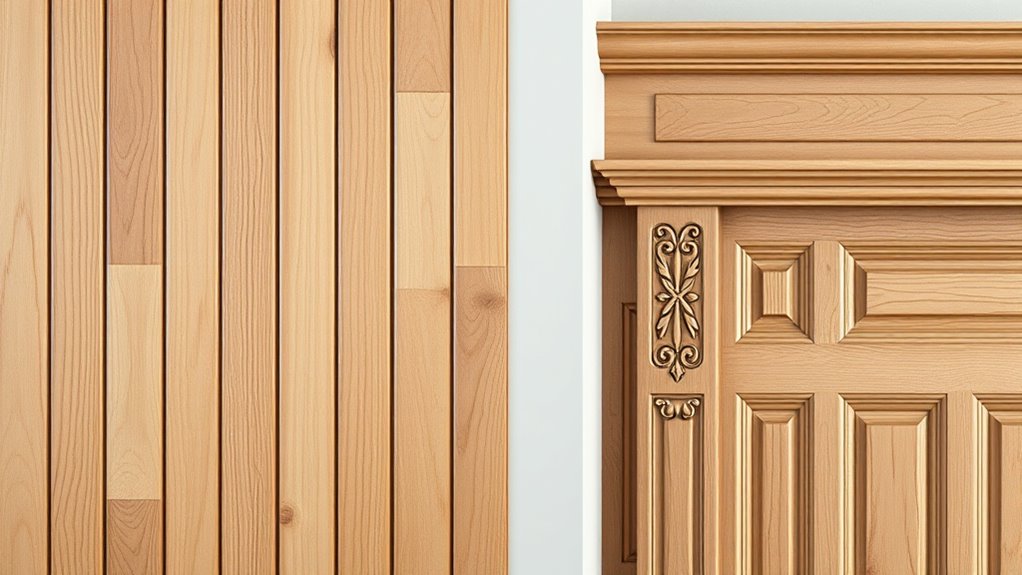
While choosing between board and batten or wainscoting, it’s important to contemplate their durability and how well they hold up over time. Both options can last for years if properly maintained, but their finish durability varies. Wainscoting typically features a more sealed surface, offering better resistance to scratches and moisture, which enhances its aging resilience. Board and batten, with its exposed wood surfaces and paint or stain finishes, may require more upkeep to preserve its appearance. If you want a long-lasting solution, consider high-quality paint and sealants to improve finish durability. Ultimately, wainscoting tends to be more resilient over the years, especially in high-traffic areas, making it a reliable choice for long-term performance.
Frequently Asked Questions
How Do I Choose Between Board & Batten and Wainscoting for My Home?
You should choose based on your home’s style and your desired look. For a rustic or modern vibe, board & batten adds texture, while wainscoting offers classic elegance. Consider your installation process—board & batten is simpler and quicker, whereas wainscoting requires more detailed work. Use styling tips from designers to match your decor. Ultimately, pick the one that complements your space and fits your DIY skills.
Can These Wall Treatments Be Painted or Stained in Different Colors?
Like a blank canvas waiting for your touch, these treatments can definitely be painted or stained in different colors. You can explore custom paint options to match your decor or choose stain color choices that highlight the wood’s natural beauty. Whether you opt for vibrant hues or subtle shades, both board & batten and wainscoting offer flexibility, letting you personalize your space and create a unique, stylish statement.
Are There Eco-Friendly or Sustainable Options for Materials Used?
Yes, you can choose eco-friendly options like reclaimed wood for wall treatments, which reduce waste and environmental impact. Pair it with eco-friendly paints or stains, such as low-VOC or natural finishes, to make your project even greener. These sustainable choices enhance your home’s style while supporting environmental health, giving you a beautiful, responsible design that aligns with eco-conscious values.
What Are the Best Maintenance Practices to Preserve Their Appearance?
To preserve their appearance, you should follow consistent cleaning routines using a soft cloth or gentle cleaner to remove dust and dirt. Applying protective finishes like paint, stain, or sealant helps prevent damage from moisture and wear. Reapply these finishes as needed, typically every few years, to maintain their look. Avoid harsh chemicals and abrasive tools to keep your wood panels looking fresh and well-maintained over time.
How Do These Styles Impact Room Acoustics and Soundproofing?
Ever wondered how wall styles affect your room’s acoustics? Both board and batten and wainscoting influence sound absorption and noise reduction differently. Board and batten, with its thicker panels and gaps, often help dampen sound better, reducing echoes. Wainscoting, being more decorative and less dense, offers minimal soundproofing. Choosing the right style can enhance your space’s comfort by improving sound quality and minimizing noise distractions.
Conclusion
Just as the river shapes the land over time, your choice between board and batten or wainscoting shapes your space’s character. Both bring history and craftsmanship into your home, echoing traditions that stand the test of time. Whether you seek the bold strength of board and batten or the refined elegance of wainscoting, your decision weaves a story—one that reflects your style and endures like the timeless currents of design.
